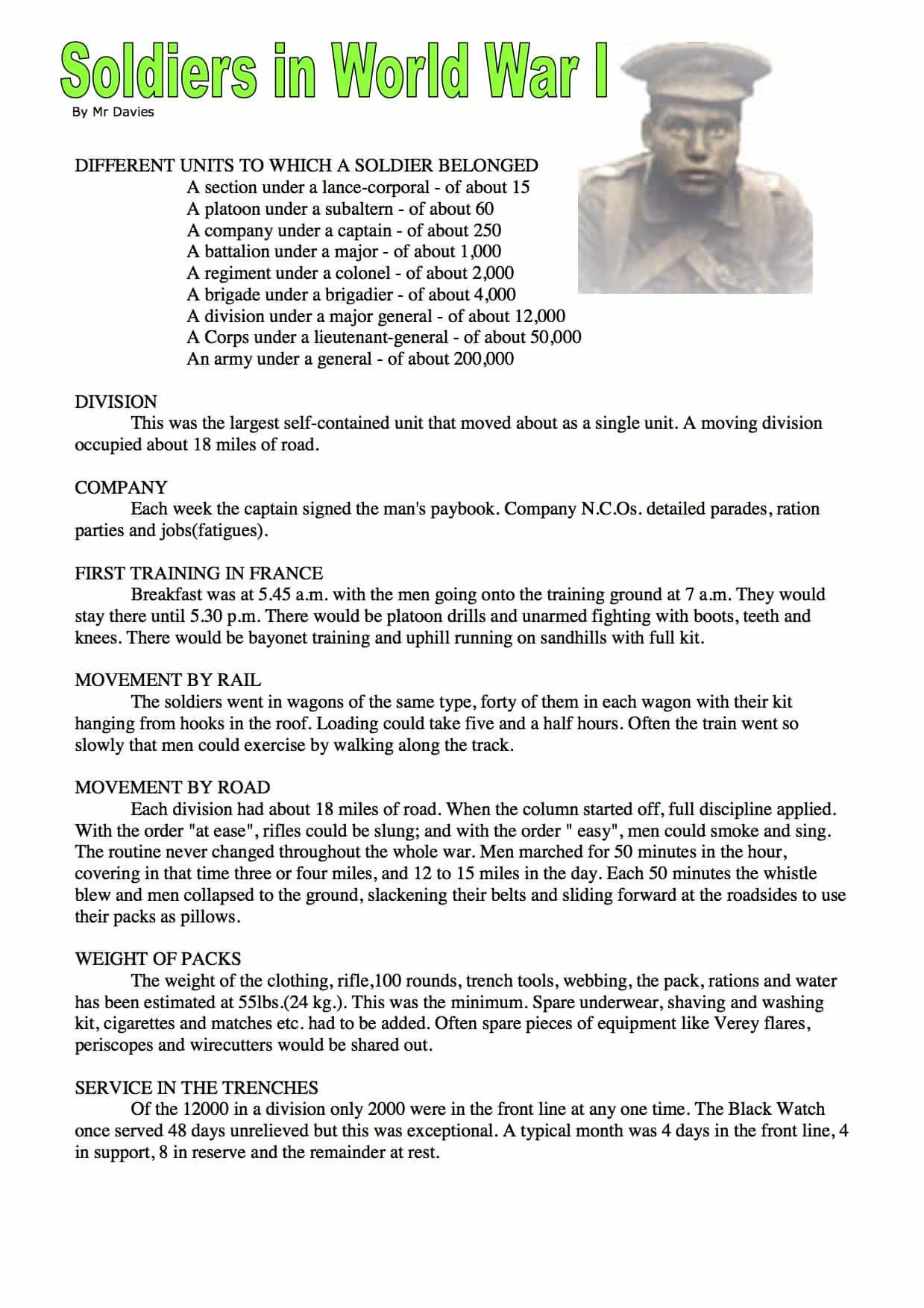Download The Soldiers in World War 1
Click the button below to download this worksheet for use in the classroom or at home.
Download →
DIFFERENT UNITS TO WHICH A SOLDIER BELONGED
A section under a lance-corporal – of about 15
A platoon under a subaltern – of about 60
A company under a captain – of about 250
A battalion under a major – of about 1,000
A regiment under a colonel – of about 2,000
A brigade under a brigadier – of about 4,000
A division under a major general – of about 12,000 A Corps under a lieutenant-general – of about 50,000 An army under a general – of about 200,000
DIVISION
This was the largest self-contained unit that moved about as a single unit. A moving division
occupied about 18 miles of road.
COMPANY
Each week the captain signed the man’s paybook. Company N.C.Os. detailed parades, ration
parties and jobs(fatigues).
FIRST TRAINING IN FRANCE
Breakfast was at 5.45 a.m. with the men going onto the training ground at 7 a.m. They would
stay there until 5.30 p.m. There would be platoon drills and unarmed fighting with boots, teeth and knees. There would be bayonet training and uphill running on sandhills with full kit.
MOVEMENT BY RAIL
The soldiers went in wagons of the same type, forty of them in each wagon with their kit
hanging from hooks in the roof. Loading could take five and a half hours. Often the train went so slowly that men could exercise by walking along the track.
MOVEMENT BY ROAD
Each division had about 18 miles of road. When the column started off, full discipline applied.
With the order “at ease”, rifles could be slung; and with the order ” easy”, men could smoke and sing. The routine never changed throughout the whole war. Men marched for 50 minutes in the hour, covering in that time three or four miles, and 12 to 15 miles in the day. Each 50 minutes the whistle blew and men collapsed to the ground, slackening their belts and sliding forward at the roadsides to use their packs as pillows.
WEIGHT OF PACKS
The weight of the clothing, rifle,100 rounds, trench tools, webbing, the pack, rations and water
has been estimated at 55lbs.(24 kg.). This was the minimum. Spare underwear, shaving and washing kit, cigarettes and matches etc. had to be added. Often spare pieces of equipment like Verey flares, periscopes and wirecutters would be shared out.
SERVICE IN THE TRENCHES
Of the 12000 in a division only 2000 were in the front line at any one time. The Black Watch
once served 48 days unrelieved but this was exceptional. A typical month was 4 days in the front line, 4 in support, 8 in reserve and the remainder at rest.
SNIPERS
These usually worked in nests, behind the front line, while a few were in camouflaged suits in
No-man’s-land. The best way to locate a sniper was to get a rough bearing from the sound and field of fire and then triangulate by using helmet or a dummy to draw fire.
LICE
These looked like tiny translucent lobsters and fed on blood about 12 times a day. They laid five
eggs daily. One way of getting rid of them was to run a lighted candle up the seams of clothes.
THE LEE ENFIELD RIFLE
This weighed just over 9 lbs and had a magazine with 10 bullets. Veterans covered the muzzle
and the bolt with cloth to keep out the mud. Rapid collective fire was more important than accuracy. The aim was to produce men who could fire 18 rounds a minute.
THE LEWIS GUN
This was 26 lbs in weight. The magazine held 48 bullets. It required a great stock of heavy
ammunition. 6 men were required to keep it in action.
THE MACHINE GUN
This was belt-fed and mounted on a tripod. There were 250 rounds in each belt. Usually each
gun had a certain area to sweep. Its main advantage was its accuracy. The tripod meant that an exhausted and frightened soldier could still fire it very effectively. It had the fire power of 40 riflemen and occupied a front of just two feet and so presented a small target to enemy snipers and gun batteries. It did need 16 men to keep it going and its weight meant that it could not be moved very easily.
AERIAL OBSERVATION
A gun cast a shadow. A gunpit broke surrounding lines with tracks leading to it or with blast
marks which gave the earth a lighter colour than usual. Newly-dug earth, reflecting white light, glinted.
PAY
The basic pay was one shilling (5 pence) per day. The average was one shilling and ninepence
(9 new pence). The men who supplied the front line troops (the Army Service Corps) might receive six shillings (30 new pence) per day and be in much less danger.
ESTAMINETS
These were French eating houses. For 4 pence a soldier could receive egg and chips, rolls and coffee in warm and comfortable surroundings. They were open from 1.30 p.m. to 8.30 p.m.
LETTERS AND PARCELS
Letters and parcels from home were regularly received. Nothing ever took linger than four days, even though name and regiment were the only permitted address.
HOME LEAVE
With 2 million men involved, just one week’s leave a year meant the movement of 40,000 men daily. In 1916 some men had not had leave for 20 months.
PDF Worksheet:
-
- Aimed at Students studying at UK GCSE or equivalent
- Free to download
- Use as you wish in the classroom or home environment
- Structured study guide and challenging questions.
